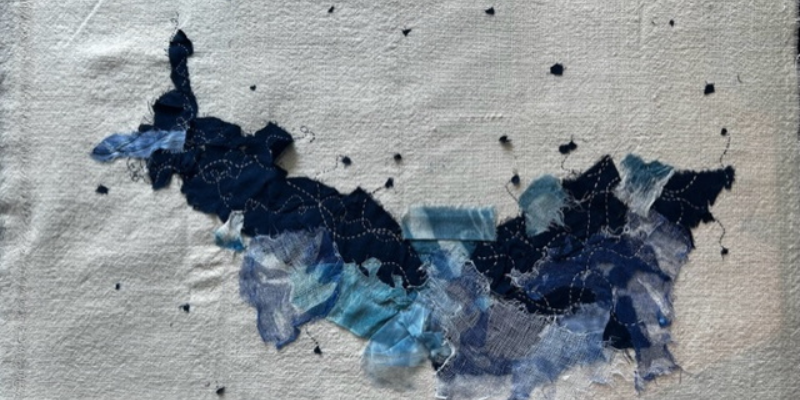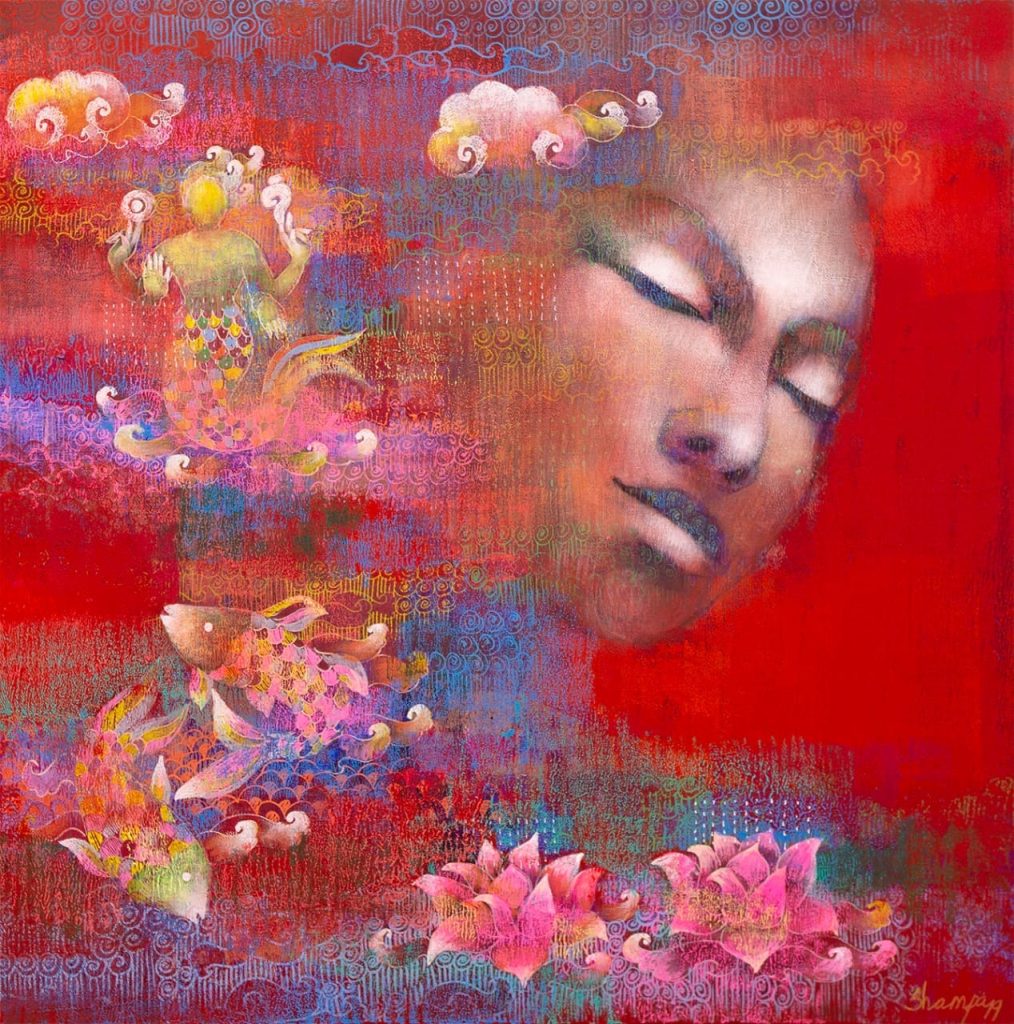“Agradoot”, a newly launched exhibition, centres around topics of significance to women. The exhibits are meticulously crafted and designed with immense creativity and careful consideration. By interrogating the individuals responsible for bringing change, the works expose their genuine essence. The way individuals coexist has undergone a transformation. The aim of this exhibition is to delve into and raise inquiries regarding the significant impact that women have in the realms of art, culture, and community. Artists have always combined pictures and words. Sometimes, artistic creations can be shaped by thoughts, while in other cases, intuitive and instinctive art sparks lively discussions about concepts. The artists participating in the exhibition have acquired their art skills both independently and through formal art education. Exploring diverse experiences and acquiring fresh knowledge is something they take pleasure in. The eleven artists – Madhvi Parekh, Shobha Broota, Jayashree Chakravarty, Arpana Caur, Jayasri Burman, Tara Sabharwal, Pranati Panda, Kanchan Chander, Sharmi Chowdhury, Radhika Surana, and Ayesha Seth Sen – invited for the exhibition are individually the makers and markers of Agradoot.
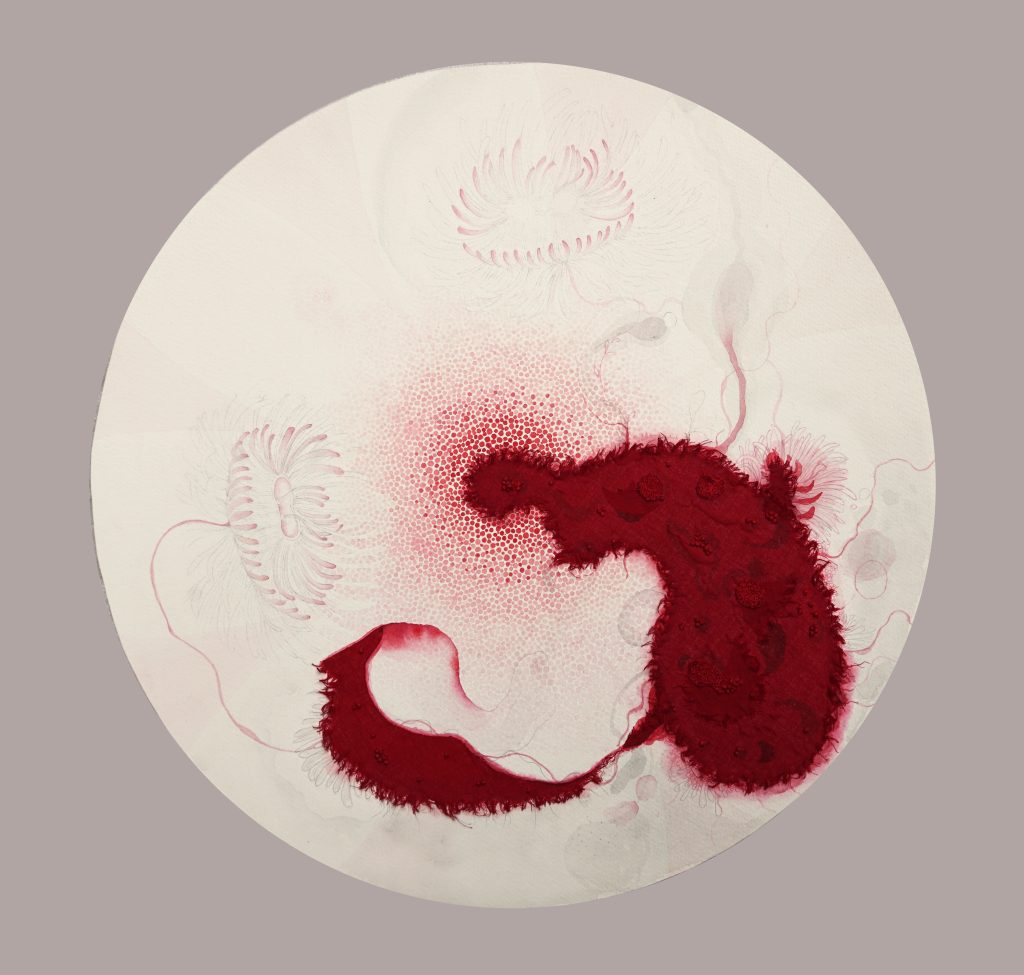 Pranati Panda, Growing within-ii, Fabric, Thread, Glue, hand-stitched embroidery, watercolour and ink on paper, 17.5 inches (dia), 2023
Pranati Panda, Growing within-ii, Fabric, Thread, Glue, hand-stitched embroidery, watercolour and ink on paper, 17.5 inches (dia), 2023
The diverse methods they employ to convey their thoughts and emotions visually truly exemplify their deep-seated preoccupations with identity, gender dynamics, self-assurance, competence, and the acquisition of knowledge. The artists in the show come from different generations and use different types of art to express their worries. Additionally, their art serves as a means of conveying a positive message. This exhibition is a project done together with Silaiwali, a group based in New Delhi. They use leftover fabric from clothes and turn it into pretty decorations. These things are made by Afghan women who have fled to India. Emphasizing the significance of women’s leadership, the primary objective of this partnership is to underscore its critical role in ongoing development efforts.
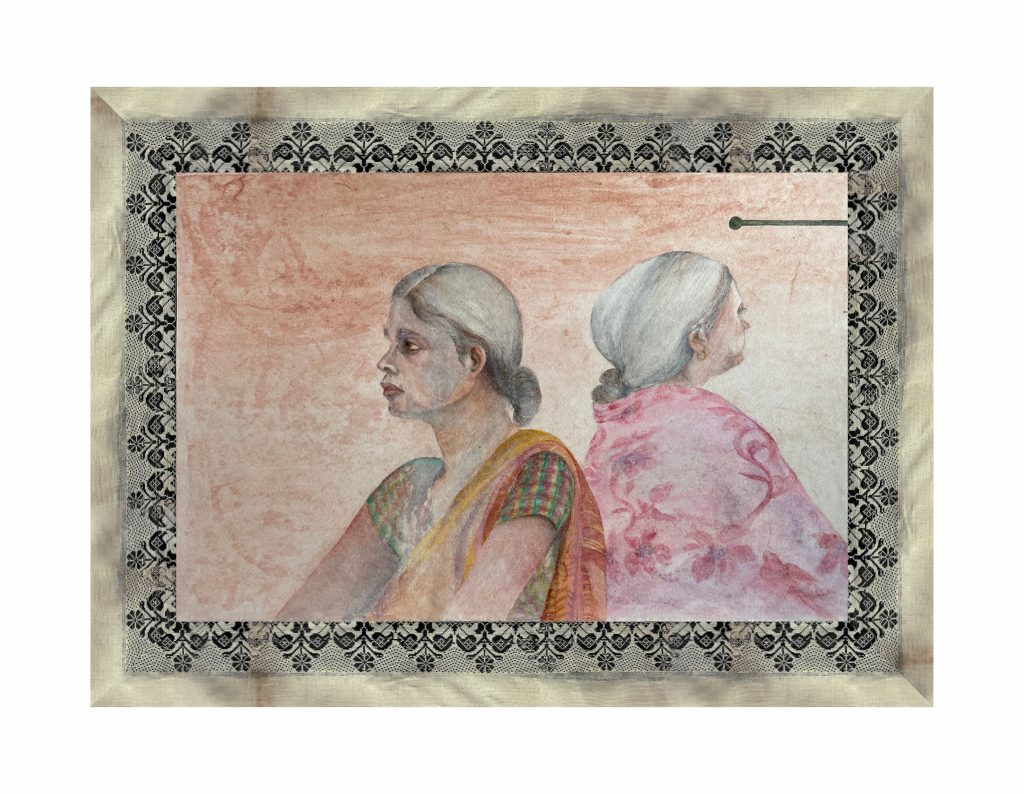 Sharmi Chowdhury, A way back to memories #1, Stone colour on archival paper, 17 x 15 inches, 2023
Sharmi Chowdhury, A way back to memories #1, Stone colour on archival paper, 17 x 15 inches, 2023
Dr. Alka Pande (Curator) shared her views with us, “When I started writing the note and when Sunaina told me that she wanted to do a woman show, so I said okay, now what we are going to do about women? and then I saw that how today women are ‘agents of change’ and because I want to go back to my own tradition, so I don’t want to use the terminology from the west. Contemporary artists, as you observe, consistently draw inspiration from the Western world. This is precisely why I find the name “Agradoot” to be so intriguing; it signifies the role of these artists as powerful catalysts for transformation. Sunaina and I always talked about it, and how it is going to be beneficial for the gallery. We have a mix of artists over here, and I wanted a diverse language also, I didn’t want to show similar work and our purpose was to see how these artists use different materials: Jayasri Burman with her painting, Madhvi Parekh with her drawings; it’s also inter-generational with the older artist, a younger artist, and medium artist.
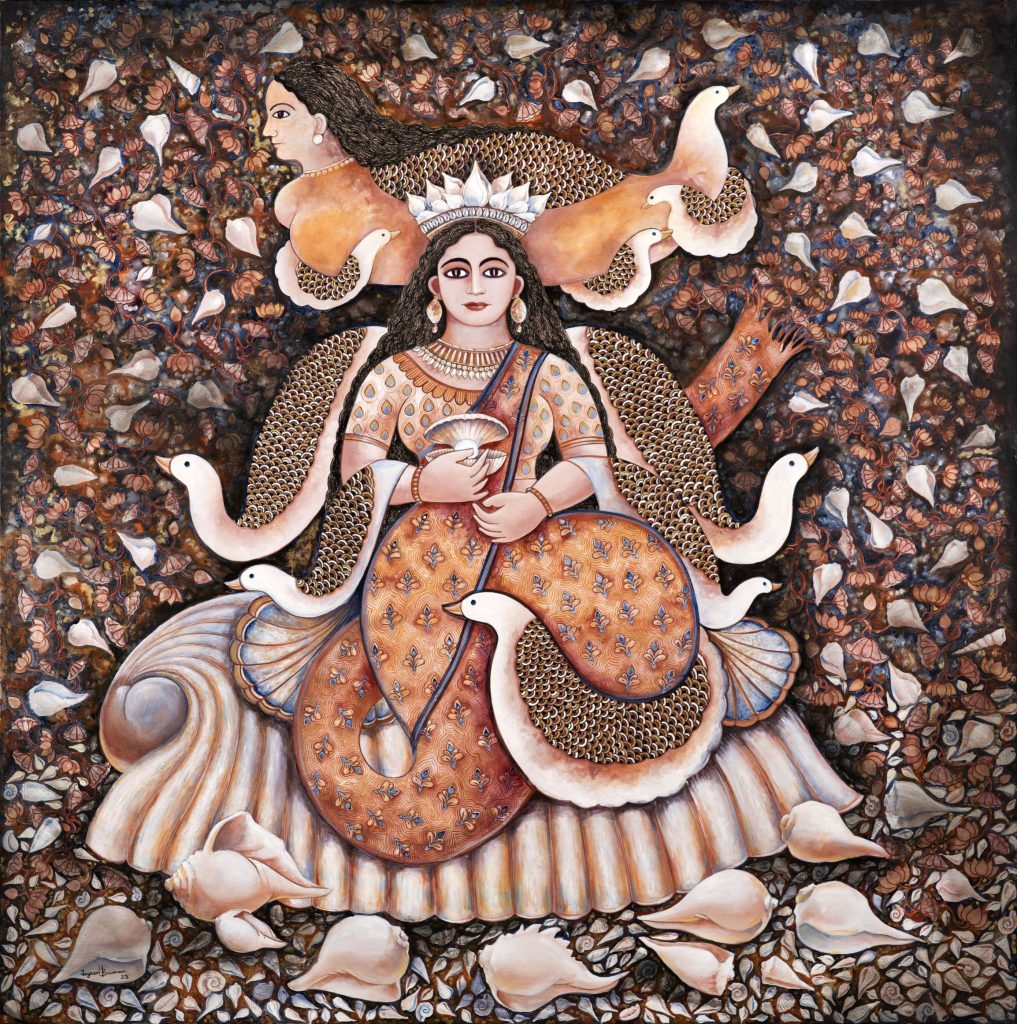 Jayasri Burman, Dooti 1, Acrylic on Canvas, 7 x 7 feet, 2023
Jayasri Burman, Dooti 1, Acrylic on Canvas, 7 x 7 feet, 2023
So older artists like Madhavi, Shobha Broota, Jayasri Burman, and Arpana Caur. Although they all have concerns, their perspectives vary. Some draw inspiration from mythology, while others, like Arpana Caur, focus on capturing the social realities of life. Additionally, Shobha Broota expresses her artistic ideas through the medium of textile art. So each one has a different language. I selected the artist based on how, because I know what each one is doing, and I put them together like Raagmalika. It’s like how to put different flowers in a garland. They also talk about different concerns, like Jayashree is talking about ecology, and Kanchan is talking about the human body, has also done different kinds of work with flowers, so she’s working with the environment, for it was about climate change. I didn’t take her earlier work only because she’s known for that work but because the whole theme is beautiful for me as it is based on the floral beauty of the country. These flowers not only represent beauty but for me, they also represent the environment and ecosystem of the art.”
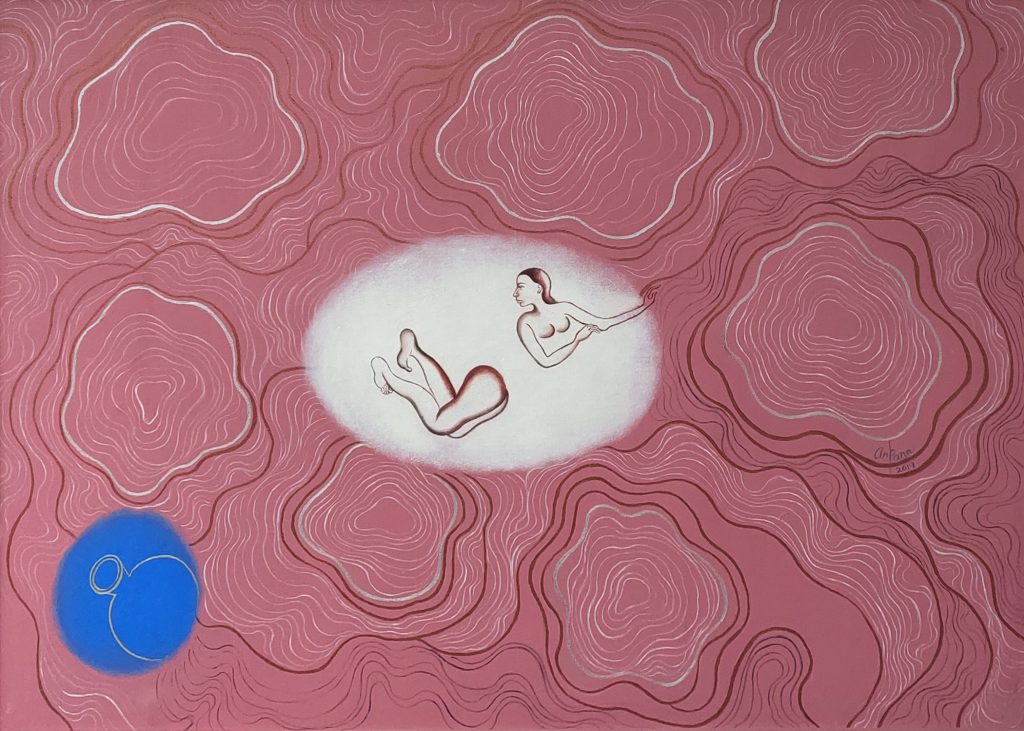 Arpana Caur, Sohni, Oil on Canvas, 4×6 feet, 2019
Arpana Caur, Sohni, Oil on Canvas, 4×6 feet, 2019
Dr. Alka Pande writes in her curatorial note, “Women have always held the home and heart together. In pastoral societies, however, with patriarchy becoming stronger, women were relegated to the kitchen and therefore took the back seat. Except in indigenous societies where women walk shoulder to shoulder with the men in the community. Inclusion is part of a civil society. Women today are finding their voice in every aspect of life and living. In a world where the boundaries of gender are continuously evolving and embracing the strength of femininity, women emerge as powerful trailblazers. They are like Agradoots, leading the way in various realms of life. Be it science, art, or business, women are at the top of the pyramid. No longer shrinking violets, as ‘stri’, they are the greatest agents of change. They are undoubtedly innovators and powerful catalysts bringing in positive results in the most difficult of experiments. Another significant marker of female identity and an area where women are creating transformative change is in the area of ecology and climate change.”
 Sharmi Chowdhury, A way back to memories, Series_ 1-9, Stone colour on archival paper, 17 x 15 inches, 2023
Sharmi Chowdhury, A way back to memories, Series_ 1-9, Stone colour on archival paper, 17 x 15 inches, 2023
Read Also:

Contributor

